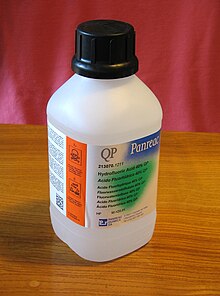
In the world of PCB manufacturing, precision and control are paramount in crafting intricate circuit patterns. One of the most potent and challenging chemical solutions utilized in the wet etching process is Hydrofluoric Acid (HF). Composed of hydrogen and fluorine, HF is a highly corrosive and hazardous acid known for its ability to dissolve various materials, including glass and metals. In this blog, we will delve into the specifics of Hydrofluoric Acid (HF) and provide valuable details on its technique for use in PCB wet etching machines, emphasizing safety and precision.
In the field of chemistry Hydrofluoric Acid belongs to which category?
Inorganic Fluxes
Inorganic fluxes are highly corrosive, and are comprised of inorganic acids and salts such as hydrochloric acid, hydrofluoric acid, stannous chloride, sodium or potassium fluoride, and zinc chloride. These fluxes are capable of removing oxide films of ferrous and nonferrous metals such as stainless steel, Kovar and nickel irons, which cannot be soldered with weaker fluxes.
Inorganic fluxes generally are used for nonelectronics applications such as the brazing of copper pipes. They are, however, sometimes used for lead-tinning applications in the electronics industry. Inorganic fluxes should not even be considered for electronics assemblies (conventional or surface mount) because of potential reliability problems. Their major disadvantage is that they leave chemically active residues than can cause corrosion and serious field failures.
Performance criteria for chemical milling
photoresists are in many ways more demanding than those of PWB fabricators; there is aplethora of different substrates such as Alloy 42,beryllium copper, iron-nickel alloys, molybdenum, tungsten, Invar, and many more. Theetching chemistries and etch conditions, which the resist must survive, are brutal. In addition to the more benign cupric chloride and the mainstream ferric chloride, you find mixtures of hydrofluoric and nitric acid which embrittle the resist, as well as very highly alkaline solutions of potassium ferrocyanide, which act like strippers on aqueous processable resists.
What is Hydrofluoric Acid (HF)?
Hydrofluoric Acid (HF) is a strong, colorless liquid acid with the chemical formula HF. Due to its reactivity and corrosiveness, HF is typically used with caution in specialized applications, such as glass etching, metal cleaning, and semiconductor manufacturing. In PCB wet etching, HF is employed to selectively remove silicon dioxide (SiO2) or glass passivation layers from semiconductor devices, enabling the creation of specific circuit patterns.

Technique of Using Hydrofluoric Acid (HF) for PCB Wet Etching:
- Preparing the HF Solution:
To prepare the HF etchant solution, dilute the concentrated HF with deionized water to achieve the desired concentration. The concentration of HF is typically expressed in percentage (%). Common concentrations for PCB wet etching are around 5% to 10% HF.
- Personal Protective Equipment (PPE):
Safety is paramount when handling HF. Always wear appropriate Personal Protective Equipment (PPE), including acid-resistant gloves, a full-face shield, chemical-resistant apron, and safety goggles to protect against splashes and inhalation of vapors.
- Proper Ventilation:
Always work with HF in a well-ventilated area or under a fume hood to prevent exposure to its toxic and corrosive vapors.
- Etching Temperature:
The etching temperature can significantly impact the etch rate and selectivity. Typically, HF etching is conducted at room temperature (around 20°C to 25°C) to ensure precision and consistency.
- Immersion Time:
The immersion time in the HF etchant solution determines the depth of etching. Longer immersion times result in deeper etching, while shorter times yield shallower patterns. The immersion time should be carefully controlled based on the desired circuit design and the thickness of the SiO2 or glass passivation layer.
- Agitation:
Gentle agitation of the etchant solution can promote an even distribution of the HF across the substrate’s surface, ensuring uniform and precise etching results.
- Neutralization and Disposal:
HF should not be neutralized with alkaline substances, as this can produce toxic and corrosive fluoride salts. Instead, HF should be treated with specific HF neutralizing agents. After etching, the spent HF solution should be carefully collected and disposed of according to environmental regulations.
Conclusion:
Hydrofluoric Acid (HF) is a powerful tool in PCB wet etching, enabling engineers to achieve precision and control in crafting intricate circuit patterns. By adhering to proper safety protocols and technique, HF can be handled with confidence, and PCB manufacturers can create high-quality and reliable electronic devices. Embrace the chemistry of HF, and elevate your PCB manufacturing process to new heights of accuracy and excellence.
As a wet process engineer, mastering the use of Hydrofluoric Acid (HF) in PCB wet etching empowers you to create cutting-edge electronic devices with flawless circuitry, revolutionizing the world of technology. Happy etching!
